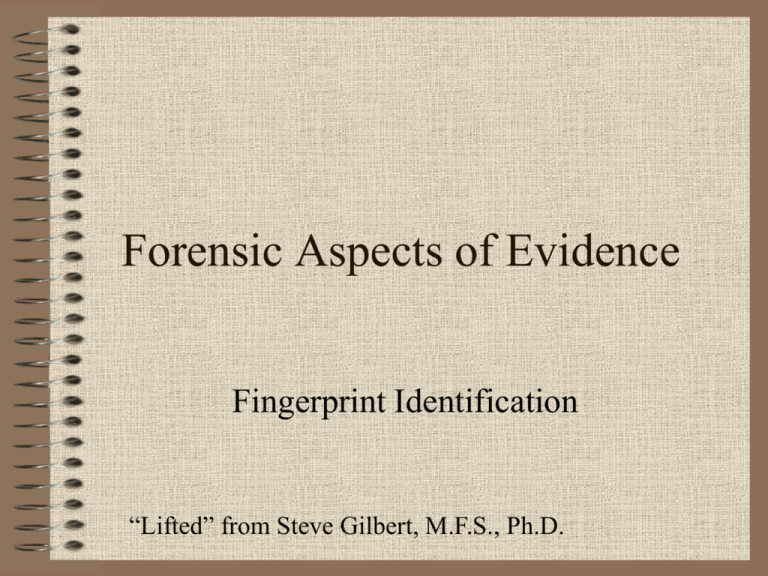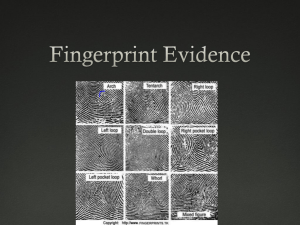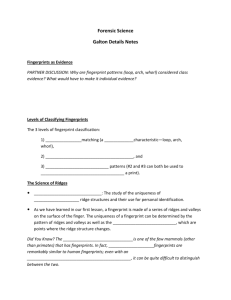JUST312 Survey of Forensic Sciences
advertisement

Forensic Aspects of Evidence Fingerprint Identification “Lifted” from Steve Gilbert, M.F.S., Ph.D. History of Fingerprints • 1684 – Nehemiah Grew reported that various patterns were present in the fingers • 1685 – Bidloo produced first fingerprint drawing • 1823 – Johannus Purkinje wrote a commentary of the skin system • 1880 – Henry Faulds stated that chance prints at scenes could identify perpetrator (Faulds) History of Fingerprints • 1892 – Francis Galton wrote his book called “Fingerprints”. Studied over 40,000 prints and failed to find any matches • 1901 – Sir Edward Henry established the first and continuing classification system • 1902 – New York began collecting fingerprints of job applicants History of Fingerprints • • • • 1903 – West Brothers case in Kansas 1904 – First fingerprint bureau 1905 – US Army began fingerprinting soldiers 1924 – FBI established FP system Parts of the Hand Distal Inter Digital Intervals Meta Carpal Crease Thenar Eminence Radial II III I Inter Digital Pads I - IV IV Ulnar Hypo Thenar Eminence Proximal Traverse Crease Distal Traverse Crease Bracelet Crease Proximal Embryology • • • • • • 6 weeks: pads II, III, IV 8 weeks: finger elongate, separate 8-12 weeks: pads round, separate pads 13 weeks: pads regress smaller 3-4 months: ridges form The number ridges dictated by fullness of finger pad Pattern Anomalies • Dissociation of Ridges – no ridges • Dysplasia – Faulty development of friction skin • Cuspal Patterns – ridges run distal to proximal rather than side to side Loops Loops opening towards the little finger is the ulnar loop, whereas the loop opening towards the thumb is the radial loop. One or more ridges enter on either side, recurve, touch or pass an imaginary line drawn from the delta to core, and terminate or tend to terminate on or toward the same side the ridge or ridges entered. Ridge Counting Ridge count: 19 The line must touch the ridge to be counted. The number of ridges intervening between the delta and the core is known as the ridge count. (yellow tick marks) Plain Arch Ridges enter on one side and flow or tend to flow out the other side with a rise or wave in the center. Tented Arch Ridges enter on one side and flow or tend to flow out the other side, however the ridges in the center do not. This possesses an angle. Tented Arch Tented arch possessing the up-thrust. Plain Whorls If an imaginary line drawn between both deltas crosses or touches a recurving ridge in the inner pattern area, the pattern is consider a plain whorl. The plain whorl has two deltas and at least one ridge making a complete circuit, which may be spiral, oval, circular, or any variant of a circle. Central Pocket Loop The central pocket loop has two deltas and at least one ridge which makes or tends to make a complete circuit. The circuit may be spiral, oval, circular or any variant of a circle. An imaginary line drawn between the two deltas must not touch or cross any recurving ridges within the inner pattern. Double Loop The double loop consists of two separate loop formations, with two separate and distinct sets of shoulders and two deltas. Accidental The accidental is a pattern consisting of a combination of two different types of patterns, with the exception of the plain arch, with two or more deltas; or a pattern which possesses some of the requirements for two or more different types; or a pattern which conforms to none of the definitions. Major Parts of Prints • Pattern area: appears in a loop or whorl in which appear the cores, deltas and ridges • Core: approximate center of the print • Delta: that point on a ridge at or in front of and nearest the center of the divergence of the type lines Pattern Area Core and Delta Core Delta Fingerprint Classification Henry System Key Major Primary Secondary Subsecondary 20 M 1 U IOI L 1 U IOI final 10 Sample classification Primary Classification • Primary: Values of whorls Finger value assignments: Fingers 1 & 2: 16 Fingers 3 & 4: 8 Fingers 5 & 6: 4 Fingers 7 & 8: 2 Fingers 9 & 10: 1 • 1 is added to all primary classifications • 1 over 1 indicates no whorls • 32 over 32 indicates no whorls Primary Classification Even fingers Odd fingers Where whorls appear in the fingers, the values are added, even over odd, with 1 added to the total. In this card, the right hand has 16+8+4+1=29 The left hand: 16+2+1=19 Secondary Classification • Secondary: the pattern appearing in the index fingers A T R U W Arch Tented Arch Radial Loop Ulnar Loop Whorl Subsecondary Classification • Subsecondary: grouping according to the ridge counts of loops and ridge tracings of whorls Major Classification • Major: Where whorls appear in the thumbs, the major division reflects whorl tracings (inner, outer, meeting) • If loops appear in the thumbs, ridge counts are used Major Classification Table Left Thumb Denominator Right Thumb Numerator 01-11 Small………………………..[01-11, Small] [12-16, Medium] [17+, Large] 12-16 Medium…………………….. [01-11, Small] [12-16, Medium] [17+, Large] 17 or more, Large…………………..[01-17, Small] [18-22, Medium] [23+, Large] Final Classification • Final: ridge count of the right little finger. *If not: ridge count in the left little finger *If not: a whorl is used * left delta to core (right hand) * right delta to core (left hand) Key Classification • Key: ridge count of the first loop appearing on the fingerprint card, exclusive of little fingers Fingerprint Processing • • • • • • Powder and brush Physical developer Small particle developer Ninhydrin Cyanoacrylate Iodine crystals The following images depict laboratory practicums of the junior Fingerprints and Impressions class. Powder and Brush Powder and Brush A camel hair brush is used to apply the fingerprint powder on suspect areas. Powder and Brush Once a print is developed, excess powder is brushed away, leaving a visible print. Powder and Brush Here, a hinge lifter is used to lift the developed print. Once applied, the print is preserved. Powder and Brush Powder and Brush The lift needs to be one fluid motion. Powder and Brush Physical Developer Documents can be washed with maleic acid and placed into the developer (yellow bath). Physical Developer Physical Developer The sample should be agitated for 5 to 15 minutes, or removed at the best print. Physical Developer The physical developer produces a dark fingerprint when applied to latent prints. Small Particle Small particle reagent is sprayed on areas of suspected latent prints. Primarily used for wet surfaces, the reagent dries leaving behind a “powdered” fingerprint. Ninhydrin Ninhydrin is used on paper products. Purple fingerprints are developed after drying for 36 hours; or heat can be applied to quicker results. Ninhydrin A household hair dryer produces enough heat. Heat the sample approximately 2-3 minutes. Ninhydrin Ninhydrin developed latent fingerprints. Cyanoacrylate Wand The wand is heated by butane. The brass tip contains cyanoacrylate (super glue). Cyanoacrylate Cyanoacrylate, or “super glue”, hardens fingerprints into white crystalline prints. Vaporization occurs with heat and humidity. Iodine Crystals Iodine can be fumed at low temperatures. Once vaporous, it develops reddish-brown fingerprints. Iodine Crystals The specimen is placed into an air-tight container along with iodine crystals. Iodine Crystals Iodine is supplied in glass ampules. Iodine Crystals The air-tight container prevents the escape of iodine vapors. Iodine Crystals Heat from the hand is sufficient to vaporize the crystals. A hair dryer produces quicker results. Iodine Crystals An iodine fingerprint. Since iodine evaporates quickly, prints should be photographed. Post Mortem Prints Kits are available for collecting fingerprints from deceased persons. Post Mortem Prints Each finger is inked with the porelon pad. Post Mortem Prints The finger is then pressed into the concave scoop which holds the print card. Post Mortem Prints All deceased persons should be printed. Once buried or cremated, prints are no longer available. Automated Technology Computer programs can now match fingerprints. The latent print (left) is matched to the record print (right). Record Fingerprints Ten-print fingerprint card. Major Case Prints Major case prints represent all friction ridge surfaces of the fingers and palm. Major Case Prints Right palm with both outer blades of the hand. Palms are rolled.





